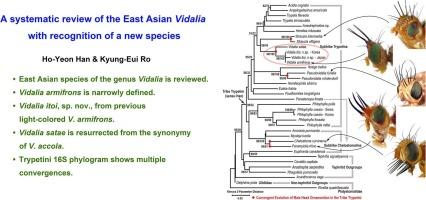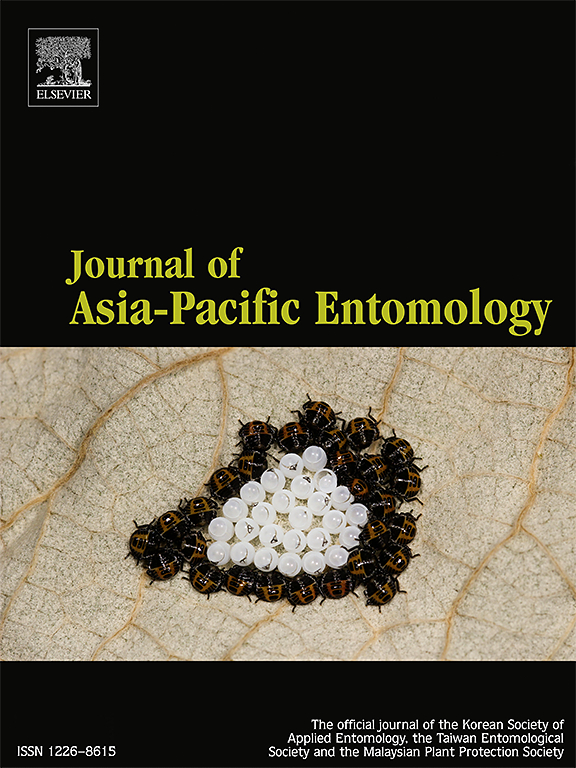东亚褐飞虱属系统综述(双翅目:绢翅虫科:绢翅虫科:绢翅虫科)并发现一新种
IF 1.3
3区 农林科学
Q3 ENTOMOLOGY
引用次数: 0
摘要
本文系统评述了东亚角头绦虫属的种类,包括V. armifrons (Portschinsky, 1892)、V. itoi Han and Ro, sp. nov.和V. satae Ito, 1984。本文提供了tripetini部落内18属26种的检索、诊断、描述、形态结构(包括生殖器)照片和16S rDNA系统图。弓形虫的物种地位以前一直不清楚。然而,根据在韩国北部采集的标本,我们能够区分浅色的V. itoi, sp. nov.和深色的V. armifrons。除了颜色的差异外,雌性针眼还表现出明显的种间变异。然而,基于16S rDNA序列,这两个物种无法区分,支持它们作为姐妹物种的地位。深色的V. armifrons似乎分布在更北部的地区(东西伯利亚,中国北部和朝鲜),而V. itoi则分布在更南部的地区,一直延伸到日本。这两个物种共存于韩国,可能也在中国和俄罗斯,但只有V. itoi在日本被发现。两个物种之间的飞行周期可能存在微小差异,可能是由于它们在韩国北部使用不同的寄主植物。基于扩大取样的V. satae,该物种从V. accola (Hardy, 1973)的同义词中复活(由于翅膀图案的显著差异)。此外,我们的16S rDNA系统图谱支持了先前提出的形态学系统发育假说:在Trypetini部落中,男性头部纹饰发生了多次独立的、趋同的进化,这可能是由攻击性雄性碰撞行为引起的强烈选择压力所驱动的。本文章由计算机程序翻译,如有差异,请以英文原文为准。

A systematic review of the East Asian Vidalia Robineau-Desvoidy (Diptera: Tephritidae: Trypetini: Trypetina), with recognition of a new species
The East Asian species of the horn-headed tephritid genus Vidalia are systematically reviewed, including V. armifrons (Portschinsky, 1892), V. itoi Han and Ro, sp. nov., and V. satae Ito, 1984. A key, diagnoses, descriptions, photographs of morphological structures (including genitalia), and a 16S rDNA phylogram of 18 genera and 26 species within the tribe Trypetini are provided. The species status of V. armifrons has previously been unclear. However, we were able to distinguish the light-colored V. itoi, sp. nov., from the dark-colored V. armifrons based on the specimens collected from northern South Korea. In addition to differences in coloration, the female aculei exhibit significant interspecific variation. Nevertheless, the two species are indistinguishable based on 16S rDNA sequences, supporting their status as sister species. The dark-colored V. armifrons appears to be distributed in more northern regions (East Siberia, northern China, and Korea), whereas V. itoi has a more southern distribution, extending as far as Japan. Both species coexist in Korea and presumably also in China and Russia, but only V. itoi is found in Japan. Minor differences in flight periods may exist between the two species, likely due to their use of different host plants in northern South Korea. Based on expanded sampling of V. satae, this species is hereby resurrected from synonymy with V. accola (Hardy, 1973) due to significant differences in wing pattern. Furthermore, our 16S rDNA phylogram supports a previously proposed morphological phylogenetic hypothesis: multiple independent, convergent evolutions of male head ornamentation have occurred within the tribe Trypetini, likely driven by intense selection pressure arising from aggressive male butting behavior.
求助全文
通过发布文献求助,成功后即可免费获取论文全文。
去求助
来源期刊

Journal of Asia-pacific Entomology
Agricultural and Biological Sciences-Insect Science
CiteScore
2.70
自引率
6.70%
发文量
152
审稿时长
69 days
期刊介绍:
The journal publishes original research papers, review articles and short communications in the basic and applied area concerning insects, mites or other arthropods and nematodes of economic importance in agriculture, forestry, industry, human and animal health, and natural resource and environment management, and is the official journal of the Korean Society of Applied Entomology and the Taiwan Entomological Society.
 求助内容:
求助内容: 应助结果提醒方式:
应助结果提醒方式:


